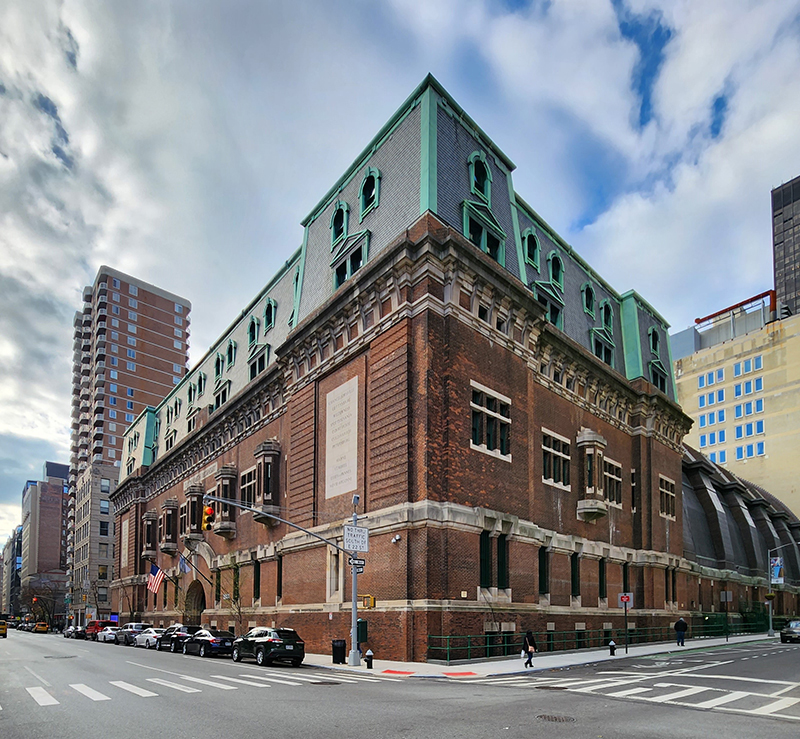
Hoffmann Architects + Engineers receives <br>Moses Award from New York Landmarks Conservancy

Manhattan, NY Hoffmann Architects + Engineers’ historic facade rehabilitation and window replacement at the 69th Regiment Armory has been selected for the Lucy G. Moses Preservation Award, the New York Landmarks Conservancy’s prestigious recognition for outstanding preservation efforts.
The Moses Award represents the Conservancy’s highest honors for excellence in preservation. The coveted awards are named for Lucy G. Moses, a dedicated New Yorker whose generosity has benefited the city for decades. The awards are made possible through the ongoing support of the Henry and Lucy Moses Fund.
The Conservancy will present the Moses Awards at a gala event on Wednesday, April 19, 2023 at 6:00pm at Saint Bartholomew’s Church.
The result of the transformation was recognized by the New York Landmarks Conservancy for preservation excellence. The restoration succeeds in returning the building to its Belle Époque aesthetic, with vastly improved safety, security, and performance.
An Icon of Beaux-Arts
Military Architecture
The 69th Regiment Armory, at 68 Lexington Ave. in the Flatiron district, was completed in 1906. The building is one of the first armories from the period to jettison the prevailing medieval-inspired castellated style in favor of Beaux-Arts architecture.
Home of the “Fighting 69th,” a fabled unit of the New York National Guard whose members served with distinction in the Civil War and World Wars I and II, the armory remains an active military complex for the Army National Guard. In addition, the barrel-vaulted drill hall is used as an exhibition space, serving as the site of the first major exhibit of modern art in America in 1913.
Given the building’s distinctive architecture and storied history, it is registered as a New York City Landmark, listed on the State and National Registers of Historic Places, and designated as a National Historic Landmark.
Showing Its Age
Integral to the armory’s character are its configured wood-frame windows. Tall and narrow at the ground floor, branching into tripartite groups in stone-trimmed oriels at the main level, then piercing the Mansard slate and copper roof at upper stories, the symmetrical windows define and ornament the masonry facades.
Concerned about deterioration and inoperability of the existing windows, the New York State Office of General Services retained Hoffmann Architects + Engineers to conduct an investigation and provide recommendations for rehabilitation. After a window-by-window study, Hoffmann’s team concluded that, due to the advanced degree of deterioration, one-for-one replacement of all existing windows and frames would be the best approach.
Ready for Active Duty
While the 69th Regiment Armory is a stunning example of turn-of-the-century Beaux-Arts design, it is also an active military facility. In addition to adhering to standards for the treatment of historic properties, the design team at Hoffmann also had to consider the very modern demands of a secure Army property. The window design, therefore, met the safety and security standards established by the New York State Division of Military and Naval Affairs, as well as the latest energy codes.
Integrating insulating glazing units that met Department of Defense anti-terrorism performance standards for blast resistance was a challenge when maintaining the original window profiles. Add to this the compound difficulty of incorporating specialized coatings and air cavities within windows to achieve Energy
Conservation Code requirements, as well as securing the heavier multi- pane units in the wall openings, and getting the designs just right was a massive undertaking.
“With the primary and most critical objective of this window replacement project being to maintain the historic integrity of the existing wood windows, it was imperative to match the historic configuration, material, operation, details, and finish,” said Richard Off, AIA, senior architect, a leader on the design team. Hoffmann’s architects and engineers accomplished this task through surveying and development of design details. Specification of the hardness and grain structure of replacement wood, paint sample analysis to formulate the framing color match, historically accurate hardware, and other particulars allowed the new windows to evoke the originals.
“This project is an exemplary candidate for the Lucy G. Moses Preservation Awards because of its careful, thorough, and detailed efforts to maintain the historic integrity of the armory and its architectural components,” said Kara Shypula, associate AIA, senior project manager with Hoffmann Architects + Engineers and one of the lead designers on the project. “The window replacement preserves historic character while seamlessly integrating contemporary performance standards unique to the building’s use as an active military facility.”